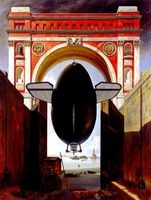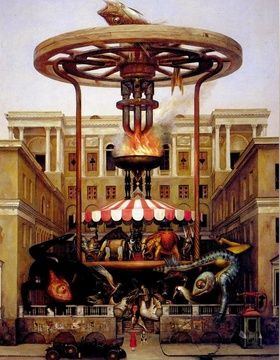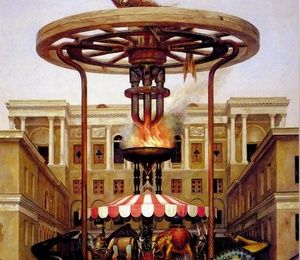Сергей Александрович Шаров
Сергей Александрович Шаров

Сергей Александрович Шаров
Родился в 1945 году в Свердловске. В 1969 году окончил Московский архитектурный институт. Занимается живописью с 1965 года. Член Московского отделения Союза художников с 1985 года. Участник художественной выставки “Двадцать московских художников” (1978-87) и выставок ARS-1 и ARS-2 в Москве, 1988. Персональная выставка в Лондоне, 1989. Его работы находятся во владении частных коллекционеров из России, США, Японии, Швеции, Германии и других стран.
Первая мысль, которая приходит вам в голову, когда вы видите работы Сергея Шарова, - это то, что он прирожденный художник. В эту эпоху безудержного дилетантизма, подчеркнутой неспособности загрунтовать холст или нарисовать человеческую фигуру, он остается верен эстетическим принципам, унаследованным от старых мастеров, и виртуозно владеет живописным мастерством. Он может передать твердость камня, мягкость пуха, текстуру шелка и человеческой плоти, прозрачность воздуха и течение воды. Это не иллюзорный китч, а, скорее, твердое безмятежное мастерство мастера. Сергей Шаров - один из основателей галереи M'ARS, первой независимой галереи современного искусства в России. В этой галерее превыше всего ценится техническое мастерство.
Парадоксально, но со вкусом и любовью нарисованный мир, который он создает на холсте, на самом деле всего лишь иллюзия, нечто среднее между сном и реальностью, фантасмагорическое видение, напоминающее “Лесную землянику” Бергмана. Если подумать, мечты могут стать реальностью большей, чем сама жизнь. Достаточно изучить искусство различных эпох и народов, эту точную хронику истории человека, чтобы увидеть, что все это образует цепь самых диких, самых нереальных саг, начиная с первобытного человека и заканчивая нашими днями.
Что делает работу Сергея Шарова особенной, по его собственным словам, так это то, что он ставит перед собой цель примирить непримиримое – “создать союз диалектики и метафизики”, разрешив их конфликт в нарисованном образе. Как ни странно, ему это удается. Специалист по средневековой демонологии, он причудливо сочетает ее с ранним европейским авангардом де Кирико и Магритта. Его работы переполнены литературными и художественными реминисценциями; он не стыдится их и не скрывает. Они являются частью естественного языка искусства, языка, посредством которого художник раскрывает свои сложные аллегорические мысли посвященным; что касается непосвященных, тех людей, которые любят упрощенное искусство, то он не намерен опускаться до их уровня или прилагать какие-либо усилия, чтобы сделать свои работы более доступными для них.
В истории искусства есть великие сюжеты, которыми занимались в каждую эпоху и которые никогда не будут исчерпаны. Одним из таких сюжетов, дошедшим до нас из средневековья, является “Искушение святого Антония”. Борьба между Добром и Злом, Светом и Тьмой, символизируемая противопоставлением Святого и разъяренных демонов, всегда привлекала художников на протяжении веков, каждый из которых привносил в эту тему свой особый смысл. Сергей Шаров также отдал дань уважения этой теме. В коллекции галереи M'ARS есть удивительное панно, выполненное им карандашом, изображающее борьбу святого с демонами. Это сложная композиция из десятков причудливых фигур, в исполнении которой художник проявляет себя так же, как и его любимый Босх. Среди этих фигур мы также находим те, которые были неизвестны в Средние века – например, сочетание форм человека и машины – кибернетический кошмар 20-го века. Несомненно, это каждый шаг нашего исторического прогресса. Они прячутся в чугунных конструкциях здания ГУМА в “Раннем утре”, выползают на передний план “Особняка”, резвятся на огнетушителе в “Всплытии”. Мы также часто сталкиваемся с ихтеосом, рыбой – раннехристианским символом Христа или человеческой души…
Но актуальность, даже в историческом контексте, - это лишь одно из значений, один из мельчайших слоев творчества Шарова. Подобно мастерам эпохи Возрождения, он создает свои картины по принципу многослойности, подобно русской матрешке: за каждым слоем скрывается другая, более глубокая идея. Эстетика Ренессанса требовала, чтобы истинное произведение искусства не было одномерным, а имело несколько смысловых оттенков: фактический (исторический), аллегорический, морально поучительный и, наконец, религиозный, духовный. Творения Шарова тесно связаны с этим образцом и могут быть интерпретированы во всех четырех вышеупомянутых категориях.
В качестве примера давайте посмотрим на “Особняк”, который явно является ключевой картиной в серии “Московские каприччио” (в которую входят “Раннее утро / Особняк / Банный дворец / Пожарная часть / Московский двор / Всплытие / Последний замок”). Эта картина изображает яркую и шумную атмосферу эпохи НЭПА 1920-х годов, но, с другой стороны, она изобилует аллегорическими высказываниями. Рыба - это не только символ Христа или человеческой души, но и символ металла (серебра), луны, холодного меланхолического темперамента (мещанина). Примус - это не только атрибут неорганизованности жизни в послереволюционный период, столь восхваляемый Зошенко, но и символ костра мирских страстей, сжигающего человеческую душу. Необычный “бестиарий” на балконе второго этажа олицетворяет семь смертных грехов, ведущих танец под звуки скрипки Смерти. Напротив Смерти - стая птиц (символ чистоты, устремляющийся ввысь), которые слушают Велимира Хлебникова, поэта-пророка, эксцентричного и непритязательного человека, читающего свои стихи (кстати, у него есть стихотворение о птицах). У этой картины есть и другой смысл – глубокий, естественно-философский (Николай Заболотский - любимый поэт художника). Четыре стихии изображены сверху донизу: воздух – вода – огонь – земля, но в этом царстве абсурда их естественная иерархия нарушена, и поэтому огонь проходит через песочные часы (время), чтобы стать землей, пылью, рассеиваясь в небытие… Мы могли бы продолжить наши интерпретации и догадки, поскольку художник предоставляет нам много материала для работы, но мы показали достаточно, чтобы продемонстрировать намерение и глубину его концепций.
Другой аспект его творчества, который часто остается незамеченным, - это юмор, который во многом смягчает напряженную атмосферу его работ. Здесь художник также следует по стопам старых мастеров: когда они устали от серьезных тем, они нарисовали демонов, окружающих святого Антония, которые были скорее юмористическими, чем пугающими.
Давайте в заключение обсудим архитектурные сооружения, которые легли в основу всех работ Сергея Шарова. Архитектор по образованию, он кропотливо подбирает пропорции, используя принцип “золотой середины” в лучших традициях архитектуры, тщательно прорисовывая каждую деталь лепнины, каждую трещину в стене. По его словам, каждая из его картин начинается с идеи здания. Более того, каждое здание, которое он рисует, действительно существует. Замечательный дом Прайса Щербатова на картине “Особняк” (художник жил там в коммунальной квартире со своей семьей после войны) до сих пор стоит на углу Садового кольца и Нового Арбата. “Московский дворик” на самом деле является воротами на ул. Солянка; когда-то там был подвал, куда распределяли заключенных по тюрьмам. Эта преисподняя была известна местным жителям как “Под ангелом”. “Банный дворец” - это бассейн на заводе имени Лихачева, а пожарная вышка до сих пор стоит рядом со станцией метро “Сокольники”. Кто знает, может быть, когда-нибудь экскурсоводы Музея современного искусства Марса проведут для посетителей специальную экскурсию по “Москве Шарова”
Аукцион искусства и старины art-picture.ru предоставляет возможность покупки
приобрести представленны лоты по теме "Сергей Александрович Шаров"

